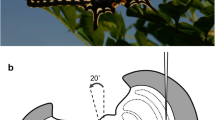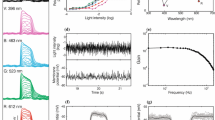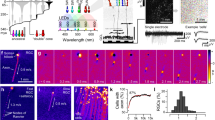Abstract
The dragonfly Hemicordulia tau has five spectral classes of photoreceptor which drive five lamina monopolars, m1-m5. The monopolars encode spectral information. Here, spectral coding by m2, m4 and m5 are described. m2 is the most sensitive to dim light. m4 and m5 are less sensitive than m2, and so we call them photopic cells. The effects of selective adaptation of receptor inputs to m4 and m5 are unusual. For example, in m4 adaptation of the green receptor suppresses the UV input, but green sensitivity is unaffected, while green adaptation of m5 increases its green sensitivity. In m5 the dark adapted spectral tuning resembles the 520 nm receptor, but on adaptation to 430 nm light this narrows markedly. Adaptation either of green or of UV receptor input to m2 and m4 modifies the time course of responses both to green and to UV, implying that changes in the time courses of monopolar responses with adaptation state do not directly reflect receptor responses (Fig. 2). Finally, the antagonistic surround of m2 is UV sensitive, and of m4 green sensitive (Fig. 3).
Similar content being viewed by others
Abbreviations
- LMC :
-
large monopolar cell
- LVF :
-
long visual fibre
- rf :
-
receptive field
- SVF :
-
short visual fibre
References
Arnett DW (1972) Spatial and temporal integration properties of units in the first optic ganglion of dipterans. J Neurophysiol 35: 429–444
Dubs A (1982) The spatial integration of signals in the retina and lamina of the fly compound eye under different conditions of luminance. J Comp Physiol 146: 321–343
de Souza J, Hertel H, Ventura DF, Menzel R (1992) Response properties of stained monopolar cells in the honeybee lamina. J Comp Physiol A 170: 267–274
Endler JA (1993) The color of light in forests and its implications. Ecological Monographs 63: 1–27
Greenstreet EH, Djamgoz MBA (1994) Triphasic chromaticity-type horizontal cells selectively contact short wavelength cone photoreceptors in the retina of a cyprinid fish, Rutilus rutilus. Proc R Soc Lond B 256: 227–230
Hardie RC (1986) The photoreceptor array of the dipteran retina. Trends in Neurosci 9: 419–423
Hateren JH van (1992) Theoretical predictions of spatiotemporal receptive fields of fly LMC's, and experimental validation. J Comp Physiol A 171: 157–170
Horridge GA, Marcelja L, Jankhe R (1985) Color vision in butterflies. I. Single color experiments. J Comp Physiol A 155: 529–542
Howard J, Dubs A, Payne R (1984) The dynamics of phototransduction in insects, a comparative study. J Comp Physiol A 154: 707–718
James AC, Osorio D (1995) Characterisation of columnar neurons and visual signal processing in the medulla of the locust optic lobe by system identification techniques. J Comp Physiol A (in press)
Jansonius NM, Hateren JH van (1991) Fast temporal adaptation in on-off units in the first optic chiasm of the blowfly. J Comp Physiol A 168: 631–637
Kamermans M, Spekreijse H (1995) Spectral behaviour of cone driven horizontal cells in teleost retina. Progress in retinal and Eye Research 14: 313–360
Laughlin SB (1974) Neural integration in the first optic neuropile of dragonflies: II. Receptor signal interactions in the lamina. J Comp Physiol 92: 357–375
Laughlin SB (1975) Receptor function in the apposition eye: an electrophysiological approach. In: Snyder AW, Menzel R (eds) Photoreceptor optics. Springer, Berlin, pp 479–498
Laughlin SB (1987) Form and function in retinal processing. Trends in Neurosci 10: 478–483
Laughlin (1994) Matching coding, circuits, cells, and molecules to signals: general principles of retinal design in the fly's eye. Progress in Retinal and Eye Research 13: 165–196
Laughlin SB, Hardie RC (1978) Common strategies of light adaptation in the peripheral visual systems of fly and dragonfly. J Comp Physiol 128: 319–340
Laughlin SB, Osorio D (1989) Mechanisms of neural signal enhancement in the blowfly compound eye. J Exp Biol 144: 113–146
Laughlin SB, Howard J, Blakeslee B (1987) Synaptic limitations top contrast coding in the retina of the blowfly Calliphora. Proc R Soc Lond B 231: 437–467
Levick WR, Cleland BG, Coombs JS (1972) On the apparent orbit of the Pulfrich pendulam. Vision Res 12: 1381–1388
Matic T (1983) Electrical inhibition in the retina of the butterfly Papilio. I. Four spectral types of photoreceptors. J Comp Physiol 150: 271–294
Meinertzhagen IA, Armett-Kibel C (1982) The lamina monopolar cells in the optic lobe of the dragonfly Sympetrum. Phil Trans R Soc Lond B 297: 27–49
Meinertzhagen IA, Menzel R, Kahle G (1983) The identification of spectral receptor types in the retina and lamina of the dragonfly Sympetrum rubicundulum. J Comp Physiol 151: 295–310
Osorio D (1991) Patterns of function and evolution in the arthopod optic lobe. In: Cronly-Dillon JR, Gregory R (eds) Vision and visual dysfunction vol. II: Evolution of the eye and visual system. Macmillan, London, pp 203–228
Osorio D, Bacon JP (1994) A good eye for arthropod evolution. Bioessays 16: 419–424
Ribi WA (1981) The first optic ganglion of the bee IV. Synaptic fine structure and connectivity patterns of receptor cell axons and first order interneurons. Cell Tissue Res 215: 413–464
Scherer C, Kolb G (1987a) Behavioral experiments on the visual processing of color stimuli in Pieris brassicae. J Comp Physiol A 160: 645–656
Scherer C, Kolb G (1987b) The influence of color stimuli on visually controlled behaviour in Aglais urticae and Paraegia aegeria (Lepidoptera). J Comp Physiol A 161: 891–898
Shaw SR (1975) Retinal resistance barriers and electrical inhibition. Nature 255: 480–483
Shaw SR (1984) Early visual processing in insects. J Exp Biol 112: 225–251
Strausfeld NJ (1976) Atlas of an insect brain. Springer, Berlin
Yang EC, Osorio D (1991) Spectral sensitivities of photoreceptors and lamina monopolar cells in the dragonfly, Hemicordulia tau. J Comp Physiol A 169: 663–669
Zettler F, Autrum H (1975) Chromatic properties of lateral inhibition in the eye of a fly. J Comp Physiol 97: 181–188
Author information
Authors and Affiliations
Rights and permissions
About this article
Cite this article
Yang, E.C., Osorio, D. Spectral responses and chromatic processing in the dragonfly lamina. J Comp Physiol A 178, 543–550 (1996). https://doi.org/10.1007/BF00190184
Accepted:
Issue Date:
DOI: https://doi.org/10.1007/BF00190184




